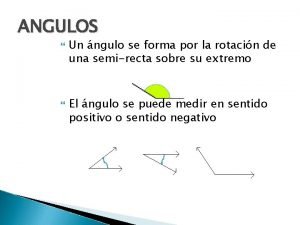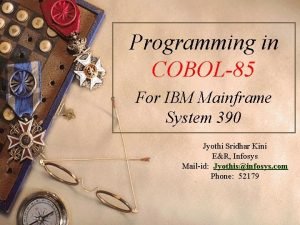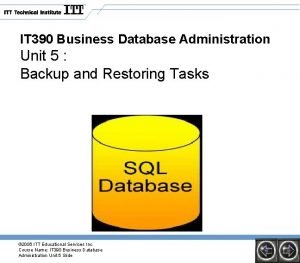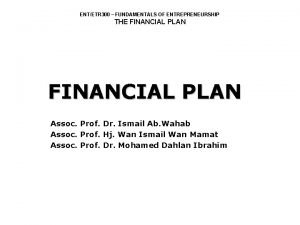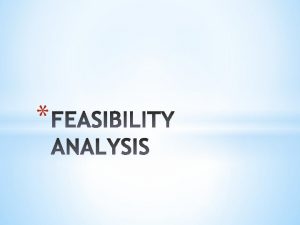Entrepreneurship for Computer Science CS 15 390 Financial
























- Slides: 24

Entrepreneurship for Computer Science CS 15 -390 Financial Intelligence- Part I Lecture 19, April 7, 2019 Mohammad Hammoud

Today… • Last Session: • Product Development- Part II: Web Applications • Today’s Session: • Financial Intelligence- Part I • Announcements: • PS 3 is due on April 9 by midnight • Project’s milestone 4 is due on April 14 by midnight (we shared the rubric over Piazza) • Quiz II is on Tuesday, April 16 during the class time • Final exam is on Wednesday, May 1 from 1: 30 to 4: 30 in Room 1030

Why Financial Intelligence? • Finance and accounting together make the language of business • They allow you to answer basic questions, alongside controlling, evaluating, and planning operations • • What does my company own? How much does it owe others? How well did (or will) its operations go? How does it (or should) get the cash to fund itself? • You need to be able to at least interpret core financial statements, which will enable you to control, evaluate, and plan operations accordingly • We will refer to this process as financial intelligence

Types of Accounting • There are two types of accounting: 1. Accrual accounting • It captures business activities irrespective of cash movement • More precisely, transactions are recorded when activities are performed • E. g. , HP sold your startup a rack of servers in March 2019, but your startup will pay HP in February 2020 • HP will record the sale (as accounts receivable), match it against its related cost, and compute the profit/loss in 2019, although it will receive the money from you in 2020 • Your startup will record the sale (as accounts payable) and accrue (or allocate) the cost of the rack over its useful time

Types of Accounting • There are two types of accounting: 2. Cash basis accounting • It captures cash movement without regard to business activities • More precisely, transactions are recorded only when cash changes hands • Anytime you get cash from a customer, you call that revenue, even if the product or service is not delivered at that time • Anytime you spend cash you call that expense • E. g. , If you pay a 2 -year rent in 2019, all the rent cost will be recorded as an expense in 2019 and NOT over a period of 2 years

Example: Cash Basis Accounting • Month 1: • You offer a service to a customer where the cost to you is $100. • The customer pays you $200 for your service. Month 1 Revenue $200 Expenses $100 Profit 200 -100= $100 Cash $100 Month 2 Month 3 Month 4 This can be viewed as an oversimplified “Income Statement” (with no taxes, no debt, no interest, etc. ), one of the three core financial statements

Example: Cash Basis Accounting • Month 2: • You offer a service to a customer where the cost to you is $200. • You and the customer agree that they can pay you $400 next month. Month 1 Month 2 Revenue $200 $0 Expenses $100 $200 Profit 200 -100= $100 -$200 Cash $100 100 -200=$-100 Month 3 Month 4

Example: Cash Basis Accounting • Month 3: • You receive $400 from the customer you offered the service to last month. • You receive $200 in advance from a customer that you have to offer a service to next month. Month 1 Month 2 Month 3 Revenue $200 $0 400+200=$600 Expenses $100 $200 $0 Profit 200 -100= $100 -$200 $600 Cash $100 100 -200=$-100+600=$500 Month 4

Example: Cash Basis Accounting • Month 4: • You offer your service to the customer who paid you last month. • The service costed you $100. Month 1 Month 2 Month 3 Month 4 Revenue $200 $0 400+200=$600 $0 Expenses $100 $200 $0 $100 Profit 200 -100= $100 -$200 $600 $-100 Cash $100 100 -200=$-100+600=$500 500 -100=$400 Profitable Non-Profitable The business is steadier than what the above seems to imply!

Example: Accrual Accounting • Month 1: Month 1 Revenue $200 Expenses $100 Profit 200 – 100 = $100 Cash $100 Accounts Receivable $0 Deferred Revenue $0 Month 2 Month 3 Month 4 A money that you will receive in the future for a service/product that you have already delivered.

Example: Accrual Accounting • Month 1: Month 1 Revenue $200 Expenses $100 Profit 200 – 100 = $100 Cash $100 Accounts Receivable $0 Deferred Revenue $0 Month 2 Month 3 Month 4 A money that you have received in advance for a service/product that you will deliver in the future.

Example: Accrual Accounting • Month 1: • You offer a service to a customer where the cost to you is $100. • The customer pays you $200 for your service. Month 1 Revenue $200 Expenses $100 Profit 200 -100 – 100==$100 Cash $100 Accounts Receivable $0 Deferred Revenue $0 Month 2 Month 3 Month 4

Example: Accrual Accounting • Month 2: • You offer a service to a customer where the cost to you is $200. • You and the customer agree that they can pay you $400 next month. Even though the customer did not pay you! Month 1 Month 2 Revenue $200 $400 Expenses $100 $200 Profit 200 -100 = $100 400 -200 = $200 Cash $100 -200+100 = $-100 Accounts Receivable $0 $400 Deferred Revenue $0 $0 Month 3 Month 4

Example: Accrual Accounting • Month 2: • You offer a service to a customer where the cost to you is $200. • You and the customer agree that they can pay you $400 next month. Month 1 Month 2 Revenue $200 $400 Expenses $100 $200 Profit 200 -100 = $100 400 -200 = $200 Cash $100 -200+100 100 -200 ==$-100 Accounts Receivable $0 $400 Deferred Revenue $0 $0 Month 3 Month 4

Example: Accrual Accounting • Month 2: • You offer a service to a customer where the cost to you is $200. • You and the customer agree that they can pay you $400 next month. Month 1 Month 2 Revenue $200 $400 Expenses $100 $200 Profit 200 -100 = $100 400 -200 = $200 Cash $100 -200+100 100 -200 ==$-100 Accounts Receivable $0 $400 Deferred Revenue $0 $0 Month 3 Month 4

Example: Accrual Accounting • Month 3: • You receive $400 from the customer you offered the service to last month. • You receive $200 in advance from a customer that you have to offer a service to next month. Month 1 Month 2 Month 3 Revenue $200 $400 $0 Expenses $100 $200 $0 Profit 200 -100 = $100 400 -200 = $200 $0 Cash $100 100 -200 = $-100+400+200= $500 Accounts Receivable $0 $400 $0 Deferred Revenue $0 $0 $200 Month 4 This is more of a liability; hence, not recorded as a revenue.

Example: Accrual Accounting • Month 4: • You offer your service to the customer who paid you last month. Month 1 Month 2 Month 3 Month 4 Revenue $200 $400 $0 $200 Expenses $100 $200 $0 $100 Profit 200 -100 = $100 400 -200 = $200 $0 $100 Cash $100 100 -200 = $-100+400+200= $500 500 -100=$400 Accounts Receivable $0 $400 $0 $0 Deferred Revenue $0 $0 $200 $0

Example: Accrual Accounting • Month 4: • You offer your service to the customer who paid you last month. • The service costed you $100. Month 1 Month 2 Month 3 Month 4 Revenue $200 $400 $0 $200 Expenses $100 $200 $0 $100 Profit 200 -100 = $100 400 -200 = $200 $0 $100 Cash $100 100 -200 = $-100+400+200= $500 500 -100=$400 Accounts Receivable $0 $400 $0 $0 Deferred Revenue $0 $0 $200 $0 The profits reflect better the activities of the business!

The Balance Sheet • The balance sheet presents: • The assets owned by your company • The liabilities owed to others • And the accumulated investment of the owners (i. e. , owner’s equity) • Assets are the resources that the company posses for future benefits • Examples: • • • Cash Inventory Accounts receivable Equipment Buildings

The Balance Sheet • Liabilities are dollar-specific obligations to pay or repay, and other obligations to provide products or services to others • Examples: • Bank debt • Accounts payable (i. e. , amount owed to suppliers) • Prepaid accounts or “deferred revenues” (i. e. , advances from customers to deliver products or services) • Taxes owed (or taxes payable) • Wages owed to employees (or wages payable)

The Balance Sheet • Owner’s equity is the accumulated dollar measure of the investments made by the owners in the company • Examples (more on these later) • Common stock • Paid-in-capital (i. e. , the funds raised by the company from equity and not from ongoing operations) • Retained earnings (i. e. , reinvestment of earnings) • As its name implies, the balance sheet is a “balance” sheet, where: • Assets (A) = Liabilities (L) + Owner’s Equity (OE)

Very Simple Example Balance Sheet- End of Month 1 A DR = 0 L Cash: $100 Equity: AR: $0 $100 OE Income statement of month 2 on an accrual basis Balance Sheet- End of Month 2 A DR = 0 L Cash: -$100 Equity: AR: $400 $300 Month 1 Month 2 Month 3 Month 4 Revenue $200 $400 $0 $200 Expenses $100 $200 $0 $100 Profit 200 -100 = $100 400 -200 = $200 $0 $100 Cash $100 100 -200 = $-100+400+200= $500 500 -100=$400 Accounts Receivable (AR) $0 $400 $0 $0 Deferred Revenue (DR) $0 $0 $200 $0 OE

Very Simple Example Balance Sheet- End of Month 1 A DR = 0 L Cash: $100 Equity: AR: $0 $100 OE Income statement of month 2 on an accrual basis Balance Sheet- End of Month 2 A DR = 0 L Cash: -$100 Equity: AR: $400 $300 Month 1 Month 2 Month 3 Month 4 Revenue $200 $400 $0 $200 Expenses $100 $200 $0 $100 Profit 200 -100 = $100 400 -200 = $200 $0 $100 Cash $100 100 -200 = $-100+400+200= $500 500 -100=$400 The balance sheet is$0 a snapshot of $400 a company’s holdings at a given $0 time, Accounts $0 Receivable (AR)the income statement shows the “flow” of activities and while Deferred Revenue transactions $0 $0 $0 over a specific period of$200 time. (DR) OE

Next Class • Financial Intelligence- Part II
 Introduction to entrepreneurship module
Introduction to entrepreneurship module Eosint p 390
Eosint p 390 Cse 390
Cse 390 Seno coseno tangente cotangente
Seno coseno tangente cotangente Ogle-2005-blg-390
Ogle-2005-blg-390 Sony dxc 390
Sony dxc 390 714 onluğa yuvarlama
714 onluğa yuvarlama Ece 390
Ece 390 Sec 390
Sec 390 Ibm system/390
Ibm system/390 It 390
It 390 Cse 390
Cse 390 Tan 390 degrees
Tan 390 degrees Cse 390
Cse 390 Ee 390
Ee 390 Os/390
Os/390 My favorite subject is music
My favorite subject is music Entetr
Entetr Entrepreneurship feasibility analysis
Entrepreneurship feasibility analysis Formuö
Formuö Novell typiska drag
Novell typiska drag Nationell inriktning för artificiell intelligens
Nationell inriktning för artificiell intelligens Vad står k.r.å.k.a.n för
Vad står k.r.å.k.a.n för Shingelfrisyren
Shingelfrisyren En lathund för arbete med kontinuitetshantering
En lathund för arbete med kontinuitetshantering



